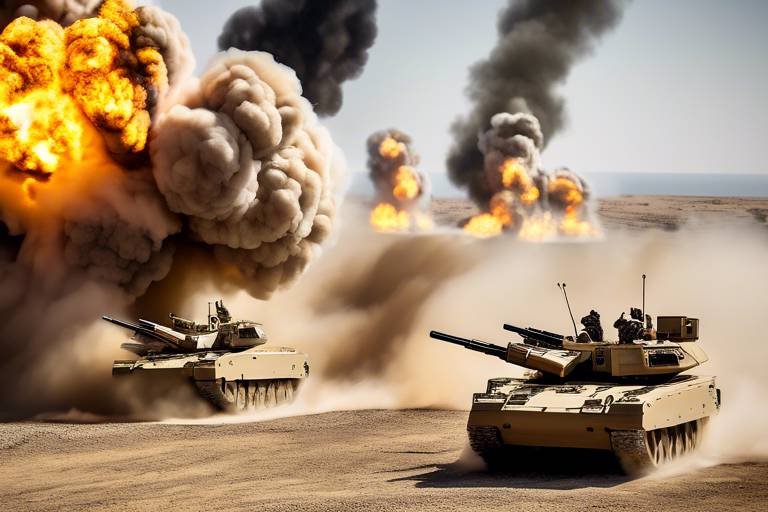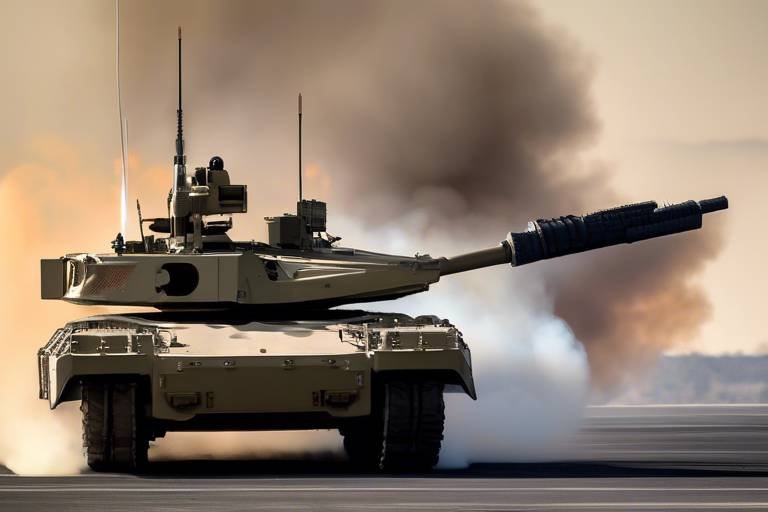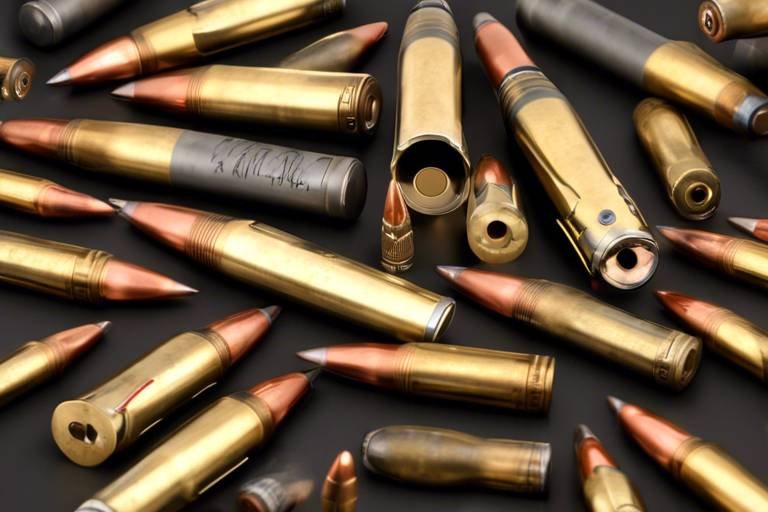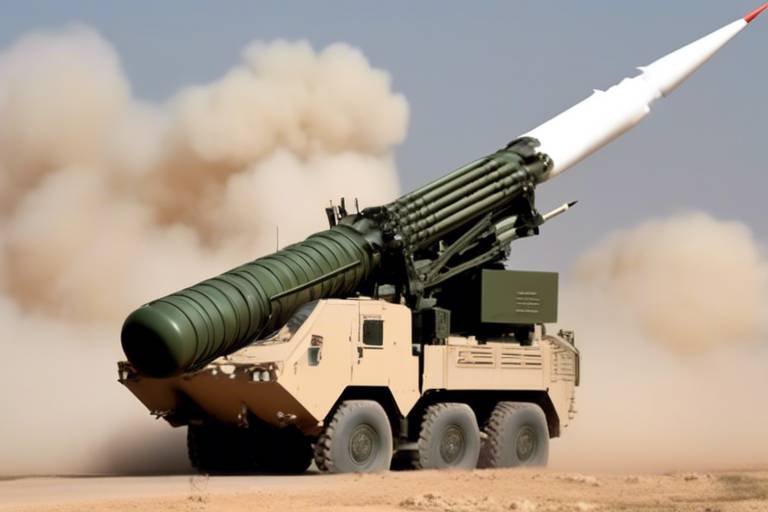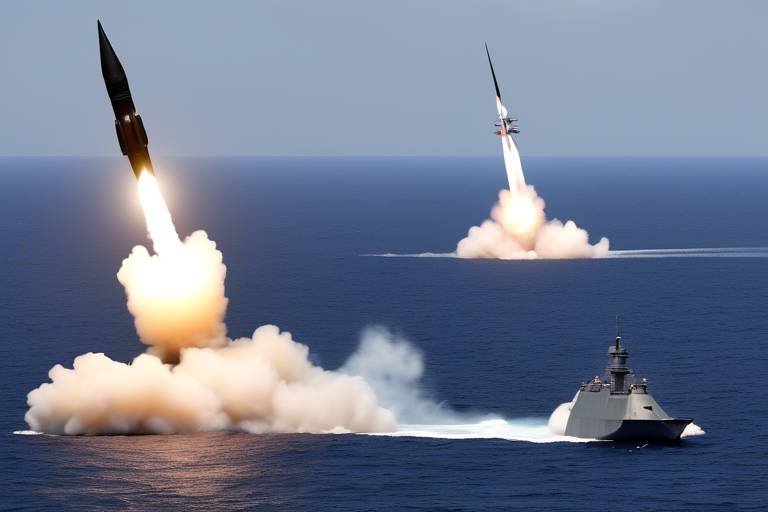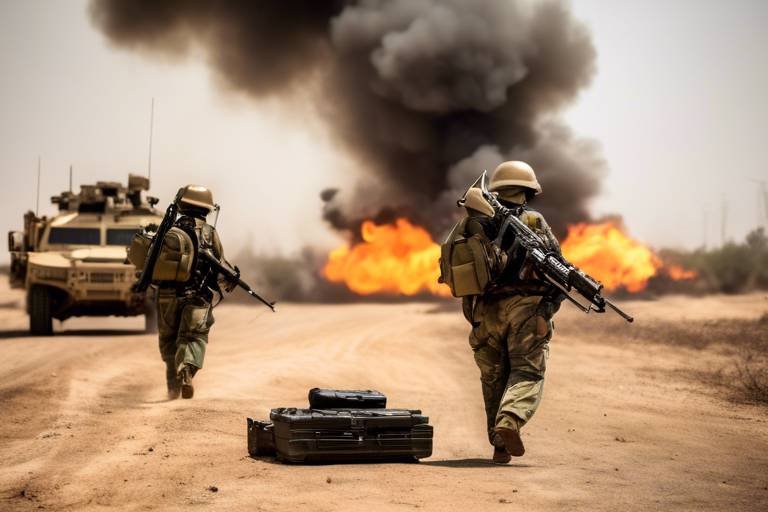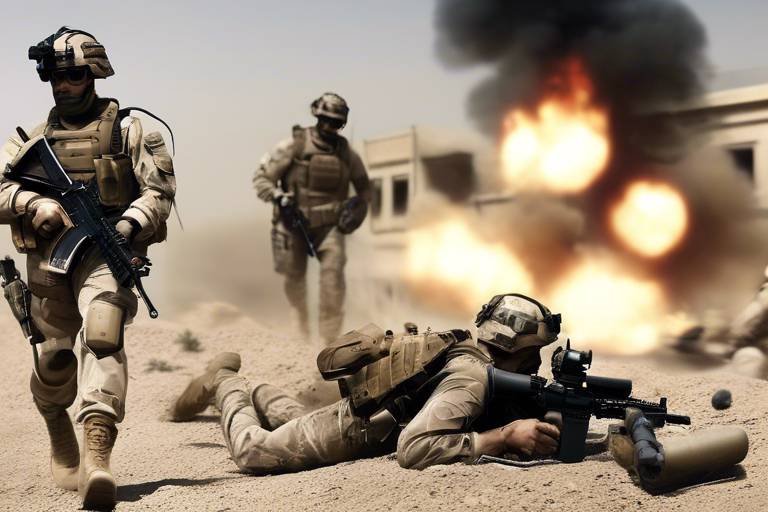The Future of Ballistic Missile Defense Systems
The world is changing at a breakneck pace, and with it, the threats we face are evolving. As nations grapple with the complexities of modern warfare, ballistic missile defense systems have emerged as a critical component of national security. These systems are not just technological marvels; they represent a country's commitment to protecting its citizens and maintaining stability in an increasingly tumultuous global landscape. But what does the future hold for these systems? Will they be able to keep up with the rapid advancements in missile technology? In this article, we will explore the advancements, challenges, and implications of ballistic missile defense systems, highlighting their importance in safeguarding nations against potential threats.
In recent years, we have witnessed a flurry of innovations in missile defense technology. From sophisticated radar systems that can detect incoming threats at unprecedented ranges to advanced interception methods that promise greater accuracy, the landscape of missile defense is transforming. These advancements are not merely incremental; they are revolutionary. Imagine a world where a missile launched from hundreds of miles away can be neutralized before it even enters your airspace. This is not science fiction; it's becoming a reality thanks to cutting-edge technologies like phased-array radar and kinetic interceptors.
As missile threats evolve, so too do the military strategies of nations around the globe. Countries are reevaluating their defense postures, integrating missile defense systems into broader military doctrines. This shift is not just about protecting borders; it's about shaping international relations. Nations that invest in robust missile defense systems send a clear message to potential adversaries: they are serious about their security. But how does this impact global diplomacy? The answer is complex, as missile defense can be both a deterrent and a source of tension among nations.
Across the globe, various regions are taking the initiative to develop their own missile defense systems tailored to counter specific threats. For instance, Europe has been ramping up its efforts, particularly in response to perceived threats from the East. Similarly, Asian nations are investing heavily in missile defense to address the growing capabilities of neighboring countries. The strategic significance of these initiatives cannot be overstated, as they not only enhance regional security but also influence global power dynamics.
In a world where threats are increasingly transnational, international partnerships are becoming crucial for effective missile defense. Countries are engaging in joint exercises and sharing technology to bolster collective security. This collaboration is akin to a neighborhood watch program, where nations come together to protect their common interests. By pooling resources and expertise, allied nations can create a more formidable defense against missile threats.
However, despite the benefits of collaboration, regional cooperation in missile defense is fraught with challenges. Political tensions, differing defense priorities, and historical grievances can hinder effective partnerships. For instance, the dynamics between nations in a region may complicate joint defense initiatives, leading to a patchwork of systems that are not fully interoperable. Understanding these challenges is essential for developing a cohesive and effective missile defense strategy.
As missile technology continues to advance, new threats are emerging on the horizon. This evolution necessitates that missile defense systems adapt accordingly. For example, the rise of hypersonic missiles poses a unique challenge, as these weapons can travel at speeds exceeding five times the speed of sound, making interception incredibly difficult. To counter these advanced missile designs and tactics, missile defense systems must evolve, incorporating new technologies and strategies to stay ahead of the curve.
While the technological advancements in missile defense are impressive, the financial implications cannot be ignored. Developing and maintaining these systems requires significant investment. Budgetary constraints and economic factors play a crucial role in shaping defense spending decisions. Policymakers must balance the need for robust defense capabilities with the realities of limited resources, often leading to tough choices.
To maintain effective missile defense systems, continued investment in research and development is essential. Funding trends indicate a growing recognition of the importance of innovation in this field. By prioritizing R&D, nations can ensure they are not only keeping pace with emerging threats but also developing cutting-edge technologies that can provide a decisive advantage in the event of a conflict.
Public opinion plays a critical role in shaping missile defense policies. Citizens' views on national security, defense spending, and international relations can significantly influence funding decisions and political support for missile defense initiatives. In a democratic society, it is essential for policymakers to gauge public sentiment and address concerns, as the success of missile defense systems ultimately hinges on public trust and support.
- What are ballistic missile defense systems? These systems are designed to detect, track, and intercept ballistic missiles during their flight.
- How do missile defense systems work? They utilize advanced radar and interception technologies to neutralize incoming threats before they reach their targets.
- Why are missile defense systems important? They play a crucial role in national security by protecting against potential missile attacks and enhancing global stability.
- What are the challenges facing missile defense systems? Challenges include emerging threats, budget constraints, and political tensions among nations.
Technological Advancements in Missile Defense
In today's rapidly changing world, the stakes have never been higher when it comes to national security. With the rise of ballistic threats, nations are investing heavily in cutting-edge missile defense technologies to protect their territories and populations. Recent innovations are not just incremental improvements; they represent a seismic shift in how we approach missile defense. From advanced radar systems to sophisticated interception methods, these technological advancements are revolutionizing the landscape of military defense.
One of the most significant breakthroughs has been in the realm of radar technology. Modern radar systems utilize phased array technology, which allows for rapid scanning of the skies and can track multiple incoming threats simultaneously. This capability is akin to having a highly skilled air traffic controller who can manage dozens of aircraft at once, ensuring that no potential danger goes unnoticed. As a result, nations can respond to threats with unprecedented speed and accuracy.
Moreover, interception methods have seen a dramatic transformation. Traditional systems relied on kinetic interceptors that would collide with incoming missiles, a method that, while effective, had limitations. Newer systems employ advanced guidance technologies, including laser systems and directed energy weapons, which promise to neutralize threats with even greater precision. Imagine trying to hit a bullet with another bullet; now envision using a high-powered laser to zap it out of the sky. This is the level of advancement we are witnessing today.
To illustrate the progress in missile defense technologies, consider the following table that highlights key advancements:
| Technology | Description | Impact on Defense |
|---|---|---|
| Phased Array Radar | Allows for rapid tracking of multiple targets. | Enhances situational awareness and response time. |
| Directed Energy Weapons | Utilizes lasers to destroy incoming missiles. | Increases precision and reduces collateral damage. |
| Hypersonic Defense Systems | Designed to counter hypersonic missiles. | Addresses emerging threats with high-speed capabilities. |
These advancements are not merely technical feats; they have profound implications for global security dynamics. As countries enhance their missile defense capabilities, the balance of power shifts, leading to new alliances and, in some cases, increased tensions. For instance, nations that invest heavily in these technologies may find themselves at an advantage, prompting others to respond in kind. This cycle of action and reaction can create a complex web of military strategies, influencing international relations in unprecedented ways.
In conclusion, the advancements in missile defense technology are reshaping the security landscape. As nations continue to innovate and adapt to new threats, the importance of these systems in safeguarding national interests cannot be overstated. The future of missile defense is not just about technology; it's about the strategic decisions that will define global stability in the years to come.
- What are ballistic missile defense systems? They are military systems designed to detect, track, and intercept incoming ballistic missiles.
- How do radar systems contribute to missile defense? Advanced radar systems enhance detection capabilities, allowing for quicker response times against threats.
- What is the significance of directed energy weapons? They offer precise interception capabilities with minimal collateral damage compared to traditional methods.
- How do advancements in missile defense affect international relations? Enhanced missile defense capabilities can shift the balance of power, leading to new alliances and potential tensions.
Global Military Strategies and Missile Defense
In today's world, the landscape of military strategy is shifting dramatically, largely due to the evolving nature of missile threats. Countries are not only enhancing their offensive capabilities but are also investing heavily in missile defense systems to safeguard their sovereignty and protect their citizens. This shift in focus has led to a comprehensive reevaluation of military doctrines, with missile defense becoming a pivotal element in national security strategies.
Missile defense systems are no longer viewed as mere supplementary tools; they are now integral to the core of military strategies. Nations are increasingly recognizing that a robust missile defense capability can act as a deterrent against potential aggressors. By showcasing their ability to intercept and neutralize incoming threats, countries can project strength and stability in a world fraught with uncertainty. This is akin to having a well-fortified castle in the medieval era—it's not just about defending against attacks but also about sending a message to would-be invaders.
Furthermore, the integration of missile defense into broader military strategies has significant implications for international relations. Nations that invest in advanced missile defense systems often find themselves in a delicate balancing act, as these systems can provoke neighboring countries. For instance, the deployment of missile defense shields in Eastern Europe has sparked tensions with Russia, which perceives these systems as a direct threat to its security. This dynamic illustrates how missile defense can influence not only national security but also regional stability.
To better understand the various global military strategies surrounding missile defense, let’s take a closer look at how different regions are adapting:
| Region | Military Strategy Focus | Key Missile Defense Initiatives |
|---|---|---|
| North America | Integrated Defense Systems | Ground-based Midcourse Defense (GMD) |
| Europe | Collective Defense | European Phased Adaptive Approach (EPAA) |
| Asia-Pacific | Regional Security Alliances | Terminal High Altitude Area Defense (THAAD) |
| Middle East | Countering Regional Threats | Iron Dome & Arrow Systems |
As demonstrated in the table, regions like North America and Europe are focusing on integrated defense systems that leverage advanced technologies for comprehensive coverage. In contrast, the Asia-Pacific region emphasizes regional security alliances, fostering collaboration among allies to address shared threats. Meanwhile, the Middle East showcases a unique approach, developing systems like the Iron Dome to counter immediate and localized threats effectively.
In summary, the interplay between missile defense systems and global military strategies is complex and multifaceted. As nations continue to adapt to emerging threats, the importance of missile defense will only grow. The challenge lies in balancing deterrence with diplomacy, ensuring that while nations fortify their defenses, they also engage in constructive dialogue to mitigate tensions. Ultimately, the future of military strategy will hinge on how effectively countries can integrate missile defense into their broader security frameworks, ensuring both protection and stability in an increasingly interconnected world.
- What is a ballistic missile defense system? A ballistic missile defense system is designed to detect, track, and intercept incoming ballistic missiles, providing a protective shield against potential threats.
- Why are missile defense systems important? They are crucial for national security, acting as deterrents against adversaries and protecting civilian populations from missile attacks.
- How do countries collaborate on missile defense? Countries often engage in joint exercises, share technology, and develop collaborative defense strategies to enhance their collective security.
- What challenges do nations face in missile defense? Political tensions, differing defense priorities, and budget constraints can hinder effective missile defense cooperation among countries.
Regional Defense Initiatives
In today's world, the landscape of defense is rapidly evolving, and nations are taking proactive measures to safeguard their territories against the ever-present threat of ballistic missiles. have become a cornerstone of national security strategies, with various countries developing tailored systems to address specific threats in their vicinity. For instance, Europe has seen a surge in missile defense projects, particularly in response to rising tensions with certain nations. Countries like Poland and Romania are actively participating in NATO's missile defense shield, which aims to protect against potential missile attacks from adversaries. This collaborative approach not only enhances regional security but also strengthens alliances among member nations.
Meanwhile, in Asia, the situation is no less pressing. Nations such as Japan and South Korea are ramping up their missile defense capabilities due to the increasing missile tests conducted by North Korea. Japan, for instance, has invested heavily in Aegis ballistic missile defense systems, which are capable of intercepting incoming threats. The South Korean government, on the other hand, has deployed the Terminal High Altitude Area Defense (THAAD) system, further exemplifying the urgency of regional defense initiatives in the face of evolving threats.
These initiatives are not just about technology; they also involve significant diplomatic and strategic considerations. For example, the deployment of missile defense systems often leads to heightened tensions with neighboring countries that perceive these actions as aggressive. This is particularly evident in the case of China's response to THAAD in South Korea, which has led to a series of retaliatory measures. Such dynamics underscore the delicate balance nations must maintain between enhancing their defense capabilities and avoiding escalations in regional tensions.
To provide a clearer picture of these initiatives, let's take a look at a comparison of some notable regional missile defense programs:
| Country | Missile Defense System | Key Features |
|---|---|---|
| USA | Ground-based Midcourse Defense (GMD) | Interception of long-range ballistic missiles |
| Japan | Aegis Ballistic Missile Defense | Ship-based, capable of intercepting short to intermediate-range missiles |
| South Korea | Terminal High Altitude Area Defense (THAAD) | High-altitude interception, effective against short to medium-range missiles |
| Poland | NATO's Missile Defense Shield | Integrated defense system, part of a collective NATO effort |
These programs illustrate the varied approaches nations are taking to fortify their defenses against missile threats. However, while regional defense initiatives are crucial for enhancing security, they also highlight the complexities of international relations. Countries must navigate not only the technical aspects of missile defense but also the political ramifications of their choices, ensuring that their strategies align with broader diplomatic goals.
In conclusion, regional defense initiatives are a vital component of modern military strategy, reflecting the urgent need for nations to adapt to the changing threat landscape. As technology continues to advance and geopolitical tensions fluctuate, the importance of these initiatives will only grow, shaping the future of national and global security.
- What are regional defense initiatives? Regional defense initiatives refer to the strategic measures taken by countries to develop missile defense systems tailored to specific threats in their regions.
- Why are countries investing in missile defense? Countries invest in missile defense to protect their territories from potential ballistic missile attacks, ensuring national security and stability.
- How do regional defense initiatives impact international relations? These initiatives can lead to increased cooperation among allied nations but may also create tensions with adversaries who view them as aggressive moves.
Collaborative Defense Efforts
The landscape of global security is changing rapidly, and nations are beginning to recognize that collaboration is key to effectively countering missile threats. Gone are the days when countries could rely solely on their own capabilities; today, international partnerships are becoming increasingly vital. These collaborations often manifest in various forms, such as joint military exercises, technology sharing agreements, and cooperative research initiatives. By pooling resources and knowledge, countries can enhance their missile defense systems and create a more formidable deterrent against potential aggressors.
One notable example of this collaborative approach is the NATO missile defense system, which integrates the capabilities of multiple member states to provide a unified defense shield against ballistic missile threats. This system not only improves the technical capabilities of individual nations but also fosters a sense of solidarity among allies. For instance, countries like the United States, Germany, and Poland have worked together to develop and deploy advanced radar systems that can detect and track incoming missiles with remarkable precision.
Moreover, joint exercises such as the “Aegis Ballistic Missile Defense” drills exemplify how nations can simulate real-world scenarios to test their systems and improve interoperability. These exercises are crucial, as they allow participating countries to identify weaknesses in their defenses and learn from each other’s best practices. The lessons learned during these drills can lead to significant improvements in both technology and strategy, ultimately enhancing the collective security of all involved.
However, the path to successful collaboration is not without its challenges. Political tensions can often complicate defense partnerships, as nations may have differing priorities or strategic objectives. For example, while one country may focus on countering threats from a specific region, another might prioritize a broader global defense strategy. Navigating these differences requires diplomacy and a shared understanding of mutual benefits.
Despite these challenges, the advantages of collaborative defense efforts are clear. By working together, nations can not only increase their defensive capabilities but also promote stability in a world where missile threats are ever-evolving. As missile technology becomes more sophisticated, the need for a cohesive and cooperative approach to defense will only grow stronger. In the end, the future of missile defense may very well depend on the ability of nations to unite their efforts and share their resources in the face of common threats.
- What are collaborative defense efforts? Collaborative defense efforts refer to the partnerships and joint initiatives between nations to enhance their missile defense capabilities through shared technologies, resources, and strategies.
- Why are international partnerships important for missile defense? International partnerships are crucial because they allow countries to pool their resources, share best practices, and develop more effective defense systems against missile threats.
- What are some examples of collaborative missile defense systems? Examples include the NATO missile defense system and joint military exercises like the Aegis Ballistic Missile Defense drills.
- What challenges do nations face in collaborative defense efforts? Challenges include political tensions, differing defense priorities, and the need for diplomacy to align strategic objectives.
Challenges in Regional Cooperation
In the ever-evolving landscape of missile defense, regional cooperation stands as a double-edged sword. While the potential for collaborative defense initiatives is immense, several challenges hinder effective partnerships among nations. One of the most significant obstacles is the political tensions that often arise due to historical grievances or conflicting national interests. For instance, countries in a particular region may have differing perspectives on perceived threats, which can complicate joint efforts in missile defense. When one nation views a neighboring country’s military advancements as a threat, it can lead to an arms race rather than a collaborative defense strategy.
Moreover, the diverse defense priorities of nations can create friction in establishing a unified missile defense system. Each country has its own set of priorities based on its unique security landscape, which may not align with those of its neighbors. For example, while one country might prioritize defense against short-range missiles, another might focus on long-range threats. This disparity can lead to fragmented defense initiatives, where nations invest in different technologies that do not complement each other, ultimately weakening the overall regional defense posture.
Additionally, trust issues play a crucial role in regional cooperation. Nations often hesitate to share sensitive military technology or intelligence, fearing that such information could be exploited by adversaries. This lack of trust can stifle collaboration, as countries may prefer to rely on their own systems rather than engage in joint efforts that require a level of transparency and vulnerability. The need for trust extends beyond technology sharing; it also encompasses the willingness to engage in joint exercises and operations, which are vital for building operational compatibility among allied forces.
Furthermore, economic disparities among nations can impact their ability to participate equally in regional defense initiatives. Wealthier nations may have more resources to invest in advanced missile defense technologies, while less affluent countries struggle to keep pace. This imbalance can lead to a situation where only a few nations dictate the terms of cooperation, leaving others feeling marginalized or underrepresented. In some cases, this can even result in a reluctance to engage in collaborative efforts altogether, as nations may fear that their contributions will not be valued or acknowledged.
To illustrate these challenges, consider the following table that outlines some key obstacles to regional cooperation in missile defense:
| Challenges | Description |
|---|---|
| Political Tensions | Historical grievances and conflicting interests can impede collaboration. |
| Diverse Defense Priorities | Different nations may focus on varying threats, leading to fragmented initiatives. |
| Trust Issues | Reluctance to share sensitive information can stifle cooperation. |
| Economic Disparities | Wealth gaps can limit participation in joint defense programs. |
In conclusion, while the potential for regional cooperation in missile defense is promising, the path forward is fraught with challenges. Addressing these issues requires a concerted effort among nations to build trust, align defense priorities, and foster an environment conducive to collaboration. Only then can countries effectively counter the growing missile threats that jeopardize their security and stability.
- What are the main challenges in regional missile defense cooperation?
Political tensions, diverse defense priorities, trust issues, and economic disparities are key challenges that nations face. - How can nations overcome trust issues in missile defense?
Building trust requires transparency, joint exercises, and consistent communication among nations. - Why do countries have different defense priorities?
Each nation's security landscape is unique, influenced by geographic, political, and historical factors. - What role does economic disparity play in missile defense?
Economic disparities can limit a country's ability to invest in advanced technologies, impacting their participation in collaborative efforts.
Emerging Threats and Adaptation
In the ever-evolving landscape of global security, emerging threats pose significant challenges to existing ballistic missile defense systems. As technology advances, adversaries are continually developing more sophisticated missile designs and tactics that can outmaneuver traditional defense mechanisms. This constant evolution necessitates a proactive approach to adaptation in missile defense strategies. For instance, hypersonic missiles, which travel at speeds greater than Mach 5, have become a focal point of concern. Their ability to change direction mid-flight complicates interception efforts, making them a formidable adversary.
Moreover, the rise of asymmetric warfare tactics, where non-state actors and smaller nations leverage unconventional strategies, further complicates the defense landscape. These groups may not possess traditional ballistic missiles but can deploy cruise missiles or even drone technology to achieve their objectives. Therefore, missile defense systems must not only focus on high-tech solutions but also on comprehensive strategies that address a wide array of potential threats.
To adapt effectively, countries are investing in cutting-edge technologies such as artificial intelligence and machine learning, which can enhance predictive capabilities and improve response times during missile engagements. By integrating these technologies, defense systems can analyze vast amounts of data in real-time, allowing for quicker decision-making processes. This is akin to having a seasoned chess player who anticipates moves several steps ahead, creating a tactical advantage.
Furthermore, collaboration between nations is becoming increasingly essential in addressing these emerging threats. Countries are sharing intelligence and developing joint defense initiatives to create a unified front against common adversaries. For example, NATO's integrated air and missile defense systems exemplify how collective resources can enhance security and resilience against evolving threats. However, this collaboration is not without its challenges, as political differences and varying defense priorities can create friction among allied nations.
In summary, the landscape of missile defense is shifting rapidly. To remain effective, defense systems must evolve alongside emerging threats by embracing new technologies, fostering international cooperation, and maintaining a flexible approach to defense strategy. As we look to the future, the ability to adapt will be crucial in ensuring national and global security in an increasingly complex world.
- What are hypersonic missiles, and why are they a concern?
Hypersonic missiles are projectiles that travel at speeds exceeding Mach 5. Their speed and maneuverability make them difficult to detect and intercept, posing a significant challenge to existing missile defense systems. - How does artificial intelligence enhance missile defense?
AI can analyze large datasets in real-time, improving predictive capabilities and response times, allowing defense systems to react more swiftly to incoming threats. - Why is international cooperation important in missile defense?
Collaborative efforts allow nations to share resources, intelligence, and technology, creating a more robust defense against common threats.
Cost and Budget Considerations
The financial implications of developing and maintaining ballistic missile defense systems are significant and multifaceted. As nations grapple with the ever-evolving landscape of military threats, the allocation of resources to these defense systems becomes a matter of national priority. The cost of research, development, and deployment of advanced missile defense technologies can run into billions of dollars, raising important questions about budgetary constraints and the opportunity costs associated with such investments.
In the context of national security, the question arises: how much is a nation willing to spend to protect its citizens from potential missile threats? This consideration often leads to intense debates within governments and among the public. For instance, countries like the United States have dedicated substantial portions of their defense budgets to missile defense initiatives, reflecting the strategic importance assigned to these systems. However, this spending must be balanced against other critical areas such as healthcare, education, and infrastructure.
To provide a clearer picture, let’s break down some of the key financial components involved in missile defense:
| Cost Component | Description |
|---|---|
| Research and Development | Investment in new technologies and systems to enhance existing missile defense capabilities. |
| Procurement | Costs associated with acquiring missile defense systems, including missiles, radars, and command systems. |
| Maintenance | Ongoing costs to keep missile defense systems operational and effective over time. |
| Personnel Training | Expenses related to training military personnel to operate and manage missile defense systems. |
Moreover, the economic factors influencing defense spending decisions cannot be overlooked. For instance, during times of economic downturn, governments may face pressure to cut defense budgets, which could adversely affect missile defense programs. Conversely, in an era of rising geopolitical tensions, nations might prioritize missile defense spending, viewing it as essential for maintaining sovereignty and deterrence capabilities.
Public perception also plays a crucial role in shaping these budgetary decisions. Citizens often have varying opinions on military spending, influenced by current events, political climates, and personal beliefs about national security. This dynamic can lead to shifts in funding, as policymakers seek to align defense budgets with public sentiment. Ultimately, the challenge lies in striking a balance between adequate funding for missile defense systems and the need to address other societal priorities.
- What are ballistic missile defense systems?
Ballistic missile defense systems are military technologies designed to detect, track, and intercept incoming ballistic missiles before they reach their targets. - Why is missile defense spending important?
Investing in missile defense is crucial for national security, as it helps protect against potential threats from adversaries who possess ballistic missile capabilities. - How do budget constraints affect missile defense?
Budget constraints can limit the development and deployment of missile defense systems, potentially impacting a nation's ability to respond to emerging threats. - What influences public opinion on missile defense?
Public opinion on missile defense can be influenced by current geopolitical events, perceived threats, and political messaging regarding national security.
Investment in Research and Development
When it comes to ballistic missile defense systems, the phrase "you get what you pay for" couldn't be more accurate. The ongoing investment in research and development (R&D) is not just a line item in government budgets; it's a lifeline for national security. As missile technology becomes more sophisticated, so too must our defense mechanisms. This is not just about keeping pace; it's about staying ahead of potential threats that could jeopardize millions of lives.
In recent years, we've witnessed a surge in funding directed towards innovative technologies that enhance missile detection and interception capabilities. For instance, the integration of artificial intelligence and machine learning into radar systems is revolutionizing how we identify and track incoming threats. These technologies allow for quicker decision-making processes, enabling defense systems to respond to threats in real-time. The reality is that every dollar spent on R&D can translate into lives saved and greater global stability.
But what does this investment look like in practical terms? Let’s break down some key areas where funding is being allocated:
| Area of Investment | Description | Significance |
|---|---|---|
| Advanced Radar Systems | Development of next-gen radar that can detect stealth missiles. | Increases early warning capabilities. |
| Interception Technologies | Research into kinetic and non-kinetic interception methods. | Improves success rates of neutralizing threats. |
| Cybersecurity Measures | Ensuring missile defense systems are protected against cyber attacks. | Maintains operational integrity and trust. |
As nations grapple with the implications of these investments, it’s crucial to recognize that the cost of inaction could be far greater than the financial outlay for R&D. In a world where threats can emerge unexpectedly, having a robust missile defense system is not just a military necessity; it’s a strategic imperative. The question we must ask ourselves is: Are we doing enough to ensure our defenses are not just adequate, but exemplary?
Moreover, public perception plays a significant role in shaping these investments. Citizens often have mixed feelings about defense spending, especially when resources could be allocated to pressing social issues. Therefore, it becomes essential for governments to communicate the importance of these investments clearly and effectively. Engaging the public through educational initiatives can foster a better understanding of the complexities involved in missile defense and its direct impact on national security.
In conclusion, the future of ballistic missile defense systems hinges on sustained investment in research and development. As we look ahead, it is imperative that nations prioritize funding in this area to ensure their defense systems are not only capable of addressing current threats but are also adaptable to the evolving landscape of missile technology. A proactive approach in R&D can pave the way for a safer world, where nations can focus on collaboration rather than confrontation.
- Why is R&D important for missile defense? R&D is essential to develop advanced technologies that can effectively counter evolving missile threats.
- How does public perception influence defense spending? Public opinion can impact government budgets and priorities, making it vital for policymakers to engage citizens in discussions about national security.
- What are some emerging technologies in missile defense? Technologies such as AI, machine learning, and advanced radar systems are at the forefront of missile defense innovation.
- How do international partnerships affect missile defense? Collaborative efforts among allied nations enhance collective security and improve the effectiveness of missile defense systems.
Public Perception and Policy Impact
The relationship between public perception and missile defense policy is a complex dance, one that can sway the direction of national security strategies significantly. In an era where information spreads like wildfire, the opinions of the public can either bolster or undermine government initiatives. For instance, when a nation invests heavily in missile defense systems, the public's support often hinges on their understanding of the threats faced and the effectiveness of the proposed solutions. If the populace perceives a credible threat, they are more likely to support increased funding and advanced technologies. Conversely, if they view these systems as unnecessary or ineffective, it can lead to budget cuts and policy reevaluations.
Moreover, the media plays a pivotal role in shaping public perception. Sensationalized news reports about missile threats can lead to heightened anxiety among citizens, prompting calls for more robust defense measures. On the flip side, if the media portrays missile defense systems as overhyped and ineffective, it can foster skepticism and resistance to funding. This dynamic creates a feedback loop where public sentiment influences policy, which in turn affects public sentiment again.
Another aspect to consider is the impact of political ideologies. Different political parties may have varying stances on defense spending and missile systems, which can affect public opinion. For example, a party that prioritizes diplomacy over military spending may find itself at odds with a public that feels threatened by missile capabilities from adversaries. This discord can lead to a push-pull scenario where defense policies are constantly in flux, trying to balance national security needs with public sentiment.
Furthermore, the demographics of a nation can also influence how missile defense policies are perceived. Younger generations, who may prioritize social issues over military spending, could challenge traditional views on defense. In contrast, older populations, who may have lived through conflicts and understand the importance of military readiness, could be more supportive of missile defense initiatives. This generational divide can create tension in policy discussions, leading to a need for governments to carefully navigate public opinion.
To illustrate the significance of public perception in shaping missile defense policy, consider the following table that outlines key factors influencing public opinion:
| Factor | Influence on Public Perception |
|---|---|
| Media Coverage | Can create urgency or skepticism about missile threats. |
| Political Leadership | Influences trust in government initiatives and spending. |
| Historical Context | Past conflicts can shape current attitudes toward defense. |
| Demographics | Different age groups may prioritize issues differently. |
| Public Education | Informed citizens are more likely to support effective policies. |
In conclusion, public perception is not just a backdrop to policy-making; it is a driving force that can dictate the effectiveness and sustainability of missile defense systems. As nations navigate an increasingly complex geopolitical landscape, understanding and addressing public concerns will be crucial for the success of their defense strategies. Engaging with the public, providing transparent information, and fostering a culture of trust can help ensure that missile defense initiatives receive the support they need to thrive.
- What is the role of public opinion in defense policy? Public opinion can significantly influence government decisions on defense spending and missile defense initiatives.
- How does media coverage affect public perception? Media coverage can create urgency or skepticism about missile threats, shaping how the public views defense policies.
- Why is demographic analysis important in understanding public perception? Different age groups and demographics can prioritize issues differently, affecting overall public support for defense initiatives.
Frequently Asked Questions
- What are ballistic missile defense systems?
Ballistic missile defense systems are advanced technologies designed to detect, track, and intercept incoming ballistic missiles. They play a crucial role in national security by providing a protective shield against missile threats from adversaries.
- How do recent technological advancements improve missile defense?
Recent innovations, such as enhanced radar systems and interception methods, have significantly improved the accuracy and reliability of missile defense systems. These advancements allow nations to respond more effectively to missile threats, ensuring better protection for their populations.
- Why are countries reevaluating their military strategies regarding missile defense?
With the evolving landscape of missile threats, countries are reassessing their military strategies to ensure they can effectively counter these dangers. This reevaluation often leads to the integration of missile defense systems into broader military doctrines, influencing international relations and security alliances.
- What are some notable regional defense initiatives?
Regions like Europe and Asia have developed their own missile defense initiatives to address specific threats. These programs are strategically significant as they enhance regional security and foster collaboration among nations facing similar risks.
- How do international partnerships enhance missile defense?
International partnerships are vital for missile defense as they facilitate joint exercises and technology sharing among allied nations. These collaborative efforts strengthen collective security and improve the overall effectiveness of missile defense systems.
- What challenges do regional cooperation efforts face?
Despite the advantages of regional cooperation in missile defense, challenges such as political tensions and differing defense priorities can hinder effective collaboration. These obstacles must be addressed to ensure a unified approach to missile threats.
- How do emerging threats affect missile defense systems?
As missile technology advances, new threats emerge that require missile defense systems to adapt. This constant evolution means that defense technologies must be updated to counter advanced missile designs and tactics employed by adversaries.
- What are the cost implications of missile defense systems?
Developing and maintaining missile defense systems involves significant financial investment. Budgetary constraints and economic factors play a critical role in shaping defense spending decisions, impacting how countries prioritize their missile defense capabilities.
- Why is investment in research and development important?
Continued investment in research and development is essential for the advancement of missile defense technologies. Funding trends indicate that innovation is crucial for maintaining effective defenses against evolving missile threats.
- How does public perception influence missile defense policies?
Public opinion significantly shapes missile defense policies. Societal views can influence funding decisions and the political support necessary for missile defense initiatives, making it important for governments to consider public sentiment in their strategies.




